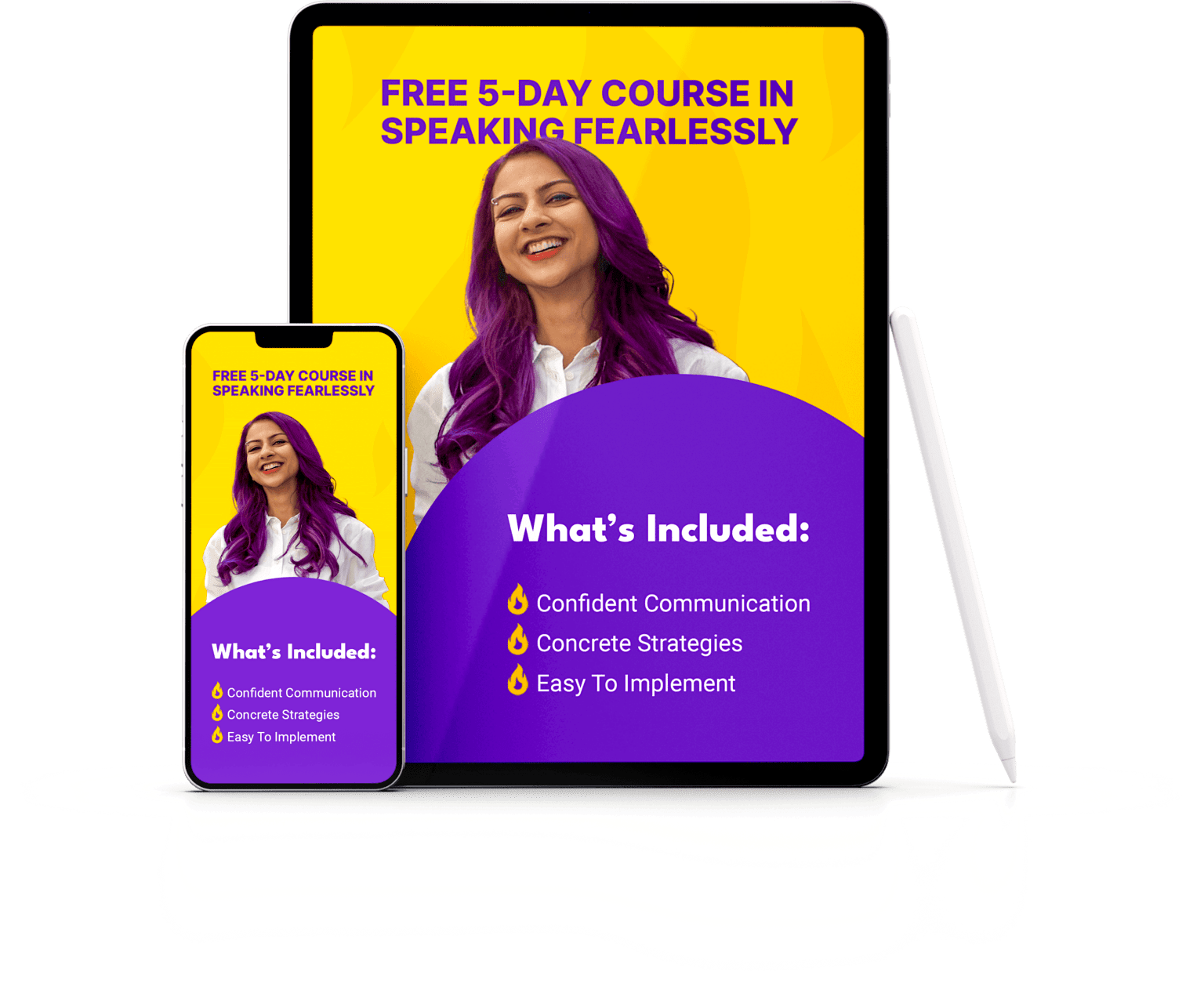Public speaking is more than just the words you say. It’s about how you say them, how you connect with your audience, and the messages you convey through your nonverbal communication.
In this comprehensive guide, we will explore the significance of nonverbal communication, the key elements that make up nonverbal cues, and practical strategies to harness this power to become a more effective and persuasive public speaker.
Table of Contents

The Silent Language
Nonverbal communication, often referred to as “the silent language,” encompasses all the ways we convey information without using words. It’s a potent form of communication because it operates on a subconscious level, influencing how our message is received and interpreted by our audience.
This encompasses a wide range of cues, including:
- Body Language: Your posture, gestures and physical movements.
- Eye Contact: The way you make and maintain eye contact with your audience.
- Proximity: How close or far you are from your audience or other individuals on the stage.
- Appearance: Your clothing, grooming, and overall appearance, which can influence your audience’s perception.
- Use of Space: How you move around the stage or speaking area, including gestures and body positioning. This even includes how you use the frame on camera if you’re speaking online.
- Silence: The pauses and moments of silence in your speech, which can convey meaning and emphasis.
- Facial Expressions: We often have a poker face which does’t do much to enhance the message we’re aiming to convey. Facial expressions that go with the message can amplify your impact.

Photo by Natasha Hall on Unsplash
The Impact of Nonverbal Communication
Nonverbal communication plays a critical role in public speaking for several reasons:
1. Conveys Emotion and Authenticity
Your facial expressions, gestures, and tone of voice allow you to express emotions authentically. When your nonverbal cues align with your message, it adds depth and authenticity to your talk. For example, a smile can convey warmth and approachability, while a furrowed brow may signal concern or seriousness.
2. Enhances Message Clarity
Nonverbal cues can clarify your message, making it easier for your audience to understand and remember. Hand gestures can illustrate key points, and vocal variations can emphasize critical information. These cues act as signposts that guide your audience through your speech.
Pro-tip: if you over-do hand gestures or use repetitive ones, they can be distracting and damage your impact instead of enhancing it.
3. Builds Connection
Effective nonverbal communication helps you establish a strong connection with your audience. Maintaining eye contact, for instance, fosters a sense of engagement and rapport. A speaker who appears confident and approachable through their body language is more likely to connect with the audience.

4. Captures Attention
Engaging nonverbal cues can capture and maintain your audience’s attention. Movement, gestures, and vocal changes can add dynamism to your speech, preventing your audience from becoming disengaged or bored.
In a world where we’re constantly bombarded with notifications and urgent tasks, gaining attention is the real currency.
5. Demonstrates Confidence
Confidence is a quality that every public speaker should exude. Nonverbal cues such as upright posture, steady eye contact, and controlled body movements convey confidence to your audience. When you appear confident, your audience is more likely to trust and respect your message.
Key Elements of Effective Nonverbal Communication
To harness the power of nonverbal communication in public speaking, it’s essential to focus on specific elements and techniques. Let’s explore these key elements:
1. Body Language
Our posture, movements, and gestures are like an open book, revealing our emotions, confidence level, and authenticity. Here’s how body language can enhance or hinder your public speaking:
Posture: Stand or sit upright with your shoulders back. Good posture exudes confidence and presence. Conversely, slouching or crossing your arms can signal insecurity or defensiveness.
Gestures: Use purposeful hand gestures to emphasize points or convey information. Avoid excessive or distracting movements.
Movement: Move purposefully and with intent. Don’t pace nervously, but rather use movement to engage different sections of the audience or transition between points. Moving purposefully and making eye contact with your audience conveys that you’re fully engaged and interested in their response.
Note for speaking online: people often ignore movement and body language when speaking on camera. But in this context, it’s even more important to be more active and confident as the audience receives less information about your presence.
Enhance your on-camera body language by being aware of the frame, using gestures that are within the frame and being intentional with the frequency and variance of your gestures.
Credibility: Avoiding distracting movements, such as fidgeting, pacing excessively or swinging in your chair. This enhances your credibility as a speaker and shows that you’re grounded (literally!).

2. Eye Contact
Maintain Connection: Make eye contact with individuals throughout your audience to create a sense of connection and engagement. This is possible to do online as well – look into the camera instead of looking at yourself or your presentation.
Avoid Staring: Don’t fixate on one person or object for too long, as it can make your audience uncomfortable. Instead, distribute your gaze evenly.
Use of Notes: If using notes or slides, ensure you don’t rely on them excessively. Maintain eye contact while referencing your materials.
Pro-tip: Don’t have full sentences on either your slides or your scripts. Have keywords instead and string together the sentences on the spot- this enhances improvisation and makes you sound fresh and natural.

3. Proximity
Your proximity to the audience and your use of personal space can create a sense of intimacy or formality:
Close Proximity: Stepping closer to the audience during a compelling point can create a feeling of closeness and connection.
This works in the online context as well – you’ll notice how the audience reacts when you lean in or when you sit back.

4. Appearance
Dress Appropriately: Your attire should align with the formality and expectations of your audience and the occasion. Dressing well can enhance your credibility.
When in doubt, go a bit more formal vs casual as a rule of thumb.
5. Use of Space
Stage Presence: Occupy the stage with confidence. Move with purpose, and use the space to engage different parts of the audience.
Avoid Excessive Movement: While movement is essential, avoid excessive pacing or aimless wandering, which can distract from your message.

Photo by Igreja Dimensão
6. Silence
Strategic Pauses: Incorporate strategic pauses into your speech to allow your audience to absorb information and emphasize key points.
There is a lot of power in the pause – use it liberally throughout your talk, presentation or podcast.
Control Filler Words: Minimize the use of filler words like “um,” “uh,” or “like.” Silence is preferable to fillers and indicates thoughtfulness.
7. Facial Expressions
Your face is a canvas of emotions, and your audience is keenly observing it. Expressions can either reinforce or contradict your spoken words:
- Smiling: A genuine smile can instantly connect you with your audience and convey warmth and approachability.
- Micro-expressions: You can say a lot with your expressions. Train your face to express emotions intentionally instead of leaving it up to the audience to insert their own emotions.
- Expressive Eyes: Your eyes can express enthusiasm, surprise, or concern, adding depth to your message.

Photo by Igreja Dimensão
Practical Strategies for Harnessing Nonverbal Communication
Now that we’ve explored the key elements of nonverbal communication, let’s dive into practical strategies for harnessing this power in your public speaking:
1. Practice, Practice, Practice
Effective nonverbal communication requires practice. Rehearse your talk or presentation multiple times, paying attention to your body language, tone of voice, and eye contact. Recording yourself can provide valuable feedback.
2. Audience Analysis
Consider your audience’s expectations, cultural norms, and preferences when it comes to nonverbal cues. Tailor your approach to resonate with your specific audience.
3. Get Feedback
Seek feedback from trusted colleagues, mentors, or speech coaches. They can offer insights into how your nonverbal cues are perceived and provide guidance for improvement.

Nausheen working with top female LinkedIn influencer Lara Acosta , giving feedback on her talk.
4. Use Visualization
Before your talk, visualize yourself delivering it with confidence and impactful nonverbal communication. Visualization can help reduce anxiety and boost your performance.
5. Mindfulness
Stay present and mindful while speaking. Be aware of your nonverbal cues and their alignment with your message. Correct any unintentional cues that may undermine your message.
6. Rehearse Transitions
Pay special attention to transitions in your speech. Smooth transitions with appropriate nonverbal cues can maintain your audience’s engagement and guide them through your message.
7. Record and Review
Record your speeches or presentations whenever possible. Reviewing the footage allows you to identify areas for improvement in your nonverbal communication. Build this as a part of your speaking and practice routine and you’ll grow your speaking skills exponentially.

8. Seek Role Models
Study accomplished public speakers and observe how they use nonverbal communication to enhance their message. Emulate their effective techniques.
Conclusion
Body language is underrated and super powerful as a tool in making you an impactful and memorable speaker.
Great non verbal communication can elevate your message and captivate your audience.
By mastering the key elements of body language, tone of voice, eye contact, appearance, use of space, and silence, and by implementing practical strategies for improvement, you can become a more effective and persuasive speaker.
Remember that nonverbal communication is not just an afterthought – it’s an integral part of the message itself. Embrace this power, and you’ll find that your impact as a public speaker transcends the spoken word alone.
If you want to work with an amazing coach who can guide you through this process of overcoming your stage fright, might I recommend myself? Find out how you can work with me and take advantage of my 10,000+ hours on stage and on camera to become a better speaker.



